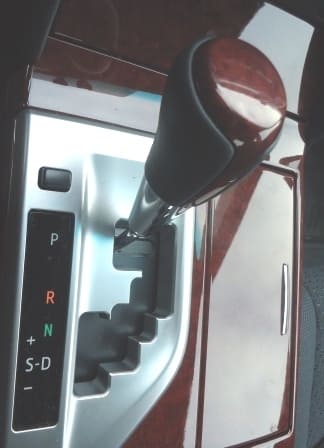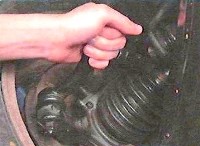Choose a gear that suits the driving conditions
Shift lever movement

When the engine switch is in the “ON” position, move the shift lever while depressing the brake pedal.
When shifting the shift lever between P and D, make sure the vehicle is at a complete stop.
Assignment of gear lever positions
- P - Park the car/start the engine
- R - Reverse
- N - Neutral position
- D - Normal Driving
- S - Driving in S*2
1: When the shift lever is in position D, the system automatically selects the appropriate gear for the driving conditions.
For normal driving, it is recommended to shift the shift lever to position D.
*2: Shifting using S mode limits the upper limit of the possible ranges of the gearbox, allows you to control the engine braking force and prevent unnecessary upshifting.
Changing gears in S mode

When the shift lever is in the S position, it can be manipulated as follows:
- 1 ─ Upshift
- 2 ─ Downshift
The initial gear range in S mode is automatically set to “3".
Gear ranges and their functions
Automatically shifts gears between 1 and 4 depending on vehicle speed and driving conditions.
Transmission is limited depending on the gear range selected.
You can choose from 4 levels of engine braking force.
Low gears provide more engine braking power than high gears; the engine speed also increases.
AI-SHIFT
In AI-SHIFT mode, the appropriate gear is automatically selected based on the driver's driving style and driving conditions.
AI-SHIFT mode is automatically enabled when the shift lever is moved to the D position (Shifting the shift lever to the S position cancels this function.)
While driving with active cruise control (if equipped)
Even if the following steps are performed to enable engine braking, engine braking will not be applied while driving in S mode and downshifting to 3 because cruise control will not be cancelled.
If the selector lever cannot be moved out of the P position
If the “S” indicator does not turn on or the “D” indicator is displayed even after shifting the shift lever to the S position
This may indicate a problem with the automatic transmission. Have your vehicle checked by your Toyota dealer immediately.
(In this situation, the transmission will operate in the same way as if the shift lever was in position D.)
Downshift limit with warning horn (S mode)
For safety and performance reasons, some downshift actions may sometimes be limited.
In some cases, downshifting may not be possible even when operating the shift lever. (In these cases, the alarm will sound twice.)
Warning
While driving on slippery road surfaces
Avoid hard depressing the accelerator pedal or sudden gear changes. Sudden changes in engine braking can cause the vehicle to skid or slide and cause an accident.
Cars without smart keyless entry:
With the ignition key in the "ON" position, depress the brake pedal and move the shift lever.
Cars with smart keyless entry:
When the “ENGINE START STOP” switch is in IGNITION ON mode, depress the brake pedal and move the shift lever.
When moving the shift lever between P and D, make sure the vehicle is stationary.
Assign lever positions
|
Position lever toggles gear |
Function |
|---|---|
|
P |
Car parking/engine start |
|
R |
Reverse |
|
N |
Neutral Position |
|
D |
Normal motion |
|
S |
Driving in S*2 |
- 1. For better fuel economy and noise reduction, set the shift lever to D for normal driving.
- 2. Shifting gears using S mode limits the upper limit of the possible ranges of the transmission, allows you to control the engine braking force and prevent unnecessary upshifts.
shift
Vehicles with smart keyless entry:
When the “ENGINE START STOP" switch is in IGNITION ON mode, depress the brake pedal and move the shift lever.
When moving the shift lever between P and D, make sure the car is stationary
Shifting gears in S mode
When the shift lever is in the S position, it can be manipulated as follows:
The start range in S mode is automatically set to "5'" or "4" depending on vehicle speed.
However, the initial range can be set to “3" if the AI-SHIFT mode is enabled while the shift lever is in the D position.
Gear ranges and their functions
You can choose from 6 levels of engine braking force.
Low gears provide more engine braking power than high gears; the engine speed also increases.
When moving the shift lever between P and D, make sure the vehicle is stationary.
S Mode
If 4 or lower gear is engaged, holding the lever in the “+” direction will engage 6 gear.
Automatic upshifting can be performed to prevent over-revving the engine
To protect the automatic transmission, there is a function that automatically upshifts when the temperature rises excessively.
AI-SHIFT
AI-SHIFT mode automatically selects the appropriate gear based on the driver's driving style and driving conditions.
AI-SHIFT mode is automatically enabled when the shift lever is moved to the D position (Shifting the shift lever to the S position cancels this function.)
When driving with cruise control (if equipped)
Even if you perform the following steps to enable engine braking, engine braking will not engage when driving in S mode and downshifting to 5 or 4 because cruise control will not be cancelled.
If the shift lever cannot be moved out of the P position
If the “S” indicator does not turn on or the “D” indicator is displayed even after shifting the shift lever to the S position
This may indicate a problem with the automatic transmission.
Have your vehicle checked by a Toyota dealer immediately (In this situation, the transmission will operate in the same way as if the shift lever was in position D.)
Downshift limit accompanied by warning horn (S mode)
For safety reasons, some downshift actions may sometimes be restricted.
In some cases, downshifting may not be possible even when operating the shift lever. (In these cases, the alarm will sound twice.)
You can choose from 4 levels of engine braking force.
Low gears provide more engine braking power than high gears; the engine speed also increases.











